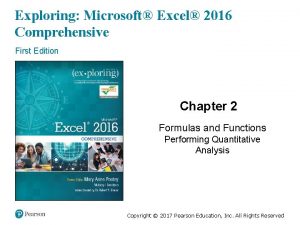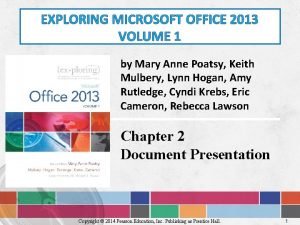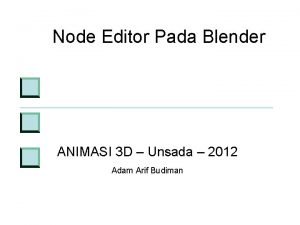Exploring Microsoft Office 2016 Series Editor Mary Anne













![Insert Basic Math and Statistics Functions (2 of 3) • =SUM(number 1, [number 2], Insert Basic Math and Statistics Functions (2 of 3) • =SUM(number 1, [number 2],](https://slidetodoc.com/presentation_image_h2/6e4be9b99635d43f857ffafb1d76e7d6/image-14.jpg)
![Insert Basic Math and Statistics Functions (3 of 3) • =MAX(number 1, [number 2], Insert Basic Math and Statistics Functions (3 of 3) • =MAX(number 1, [number 2],](https://slidetodoc.com/presentation_image_h2/6e4be9b99635d43f857ffafb1d76e7d6/image-15.jpg)



![Determine Results with the IF Function (2 of 3) • =IF(logical_test, [value_if_true], [value_if_false]) • Determine Results with the IF Function (2 of 3) • =IF(logical_test, [value_if_true], [value_if_false]) •](https://slidetodoc.com/presentation_image_h2/6e4be9b99635d43f857ffafb1d76e7d6/image-19.jpg)
![Determine Results with the IF Function (3 of 3) • =IF(logical_test, [value_if_true], [value_if_false]) • Determine Results with the IF Function (3 of 3) • =IF(logical_test, [value_if_true], [value_if_false]) •](https://slidetodoc.com/presentation_image_h2/6e4be9b99635d43f857ffafb1d76e7d6/image-20.jpg)

![Use Lookup Functions (2 of 3) • =VLOOKUP(lookup_value, table_array, col_index_num, [range_lookup]) • =VLOOKUP(E 3, Use Lookup Functions (2 of 3) • =VLOOKUP(lookup_value, table_array, col_index_num, [range_lookup]) • =VLOOKUP(E 3,](https://slidetodoc.com/presentation_image_h2/6e4be9b99635d43f857ffafb1d76e7d6/image-22.jpg)
![Use Lookup Functions (3 of 3) • =HLOOKUP(lookup_value, table_array, row_index_num, [range_lookup]) • =HLOOKUP(E 3, Use Lookup Functions (3 of 3) • =HLOOKUP(lookup_value, table_array, row_index_num, [range_lookup]) • =HLOOKUP(E 3,](https://slidetodoc.com/presentation_image_h2/6e4be9b99635d43f857ffafb1d76e7d6/image-23.jpg)

![Calculate Payments with the PMT Function (2 of 2) • =PMT(rate, nper, pv, [fv], Calculate Payments with the PMT Function (2 of 2) • =PMT(rate, nper, pv, [fv],](https://slidetodoc.com/presentation_image_h2/6e4be9b99635d43f857ffafb1d76e7d6/image-25.jpg)



- Slides: 28

Exploring Microsoft® Office 2016 Series Editor Mary Anne Poatsy Mulbery|Krebs|Hogan|Cameron |Davidson|Lau|Lawson|Williams Series Created by Dr. Robert T. Grauer Copyright © 2017 Pearson Education, Inc.

Exploring Excel 2016 Chapter 2 Formulas and Functions Performing Quantitative Analysis Copyright © 2017 Pearson Education, Inc.

Objectives • Use Relative, Absolute, and Mixed Cell References in Formulas • Insert a Function • Insert Basic Math and Statistics Functions • Use Date Functions • Determine Results with the IF Function • Use Lookup Functions • Calculate Payments with the PMT function Copyright © 2017 Pearson Education, Inc.

Objective 1: Use Relative, Absolute, and Mixed Cell References in Formulas (1 of 5) Skills: • Use a Relative Cell Reference • Use an Absolute Cell Reference • Use a Mixed Cell Reference Copyright © 2017 Pearson Education, Inc.

Use Relative, Absolute, and Mixed Cell References in Formulas (2 of 5) • Relative cell reference—default method of referencing • Absolute cell reference—provides a constant reference to a specific cell • Mixed cell reference—combines absolute and relative cell references • F 4—toggles through relative, absolute, and mixed references Copyright © 2017 Pearson Education, Inc.

Use Relative, Absolute, and Mixed Cell References in Formulas (3 of 5) G 2 contains =D 2 -E 2 Copied formula contains =D 4 -E 4 Copyright © 2017 Pearson Education, Inc.

Use Relative, Absolute, and Mixed Cell References in Formulas (4 of 5) E 3 contains =D 3*$B$4 Copied formula contains =D 4*$B$4 Copyright © 2017 Pearson Education, Inc.

Use Relative, Absolute, and Mixed Cell References in Formulas (5 of 5) E 2 contains =D 3*B$4 Copied formula contains =D 4*$B$4 Copyright © 2017 Pearson Education, Inc.

Objective 2: Insert a Function (1 of 4) Skills: • Insert a Function Using Formula Auto. Complete • Use the Insert Function Dialog Box Copyright © 2017 Pearson Education, Inc.

Insert a Function (2 of 4) Auto. Complete based on =SU Screen. Tip based on =SUM( Copyright © 2017 Pearson Education, Inc.

Insert a Function (3 of 4) Search Sum selected Category Sum syntax and description Copyright © 2017 Pearson Education, Inc.

Insert a Function (4 of 4) Function Selected cell Argument Copyright © 2017 Pearson Education, Inc.

Objective 3: Insert Basic Math and Statistics Functions (1 of 3) Skills: • Use the SUM Function • Use the AVERAGE and MEDIAN Functions • Use the MIN and MAX Functions • Use the COUNT Functions • Perform Calculations with Quick Analysis Tools Copyright © 2017 Pearson Education, Inc.
![Insert Basic Math and Statistics Functions 2 of 3 SUMnumber 1 number 2 Insert Basic Math and Statistics Functions (2 of 3) • =SUM(number 1, [number 2],](https://slidetodoc.com/presentation_image_h2/6e4be9b99635d43f857ffafb1d76e7d6/image-14.jpg)
Insert Basic Math and Statistics Functions (2 of 3) • =SUM(number 1, [number 2], …) • =SUM(A 1, A 2, A 5) • =AVERAGE(number 1, [number 2], …) • =AVERAGE(B 10: B 20) • =MEDIAN(number 1, [number 2], …) • =MEDIAN(A 2: A 14, F 2: F 14) • =MIN(number 1, [number 2], …) • =MIN(A 1, B 10: C 25) Copyright © 2017 Pearson Education, Inc.
![Insert Basic Math and Statistics Functions 3 of 3 MAXnumber 1 number 2 Insert Basic Math and Statistics Functions (3 of 3) • =MAX(number 1, [number 2],](https://slidetodoc.com/presentation_image_h2/6e4be9b99635d43f857ffafb1d76e7d6/image-15.jpg)
Insert Basic Math and Statistics Functions (3 of 3) • =MAX(number 1, [number 2], …) • =MAX(A 1, B 10: C 25) • =COUNT(number 1, [number 2], …) • =COUNT(B 10: G 50) • =COUNTBLANK(number 1, [number 2], …) • =COUNTBLANK(B 10: G 50) • =COUNTA(number 1, [number 2], …) • =COUNTA(B 10: G 50) Copyright © 2017 Pearson Education, Inc.

Objective 4: Use Date Functions (1 of 2) Skills: • Use the TODAY Function • Use the NOW Function Copyright © 2017 Pearson Education, Inc.

Use Date Functions (2 of 2) • =TODAY() • Displays a result like: 2/9/2018 • =NOW() • Displays a result like: 2/9/2018 14: 09 Copyright © 2017 Pearson Education, Inc.

Objective 5: Determine Results with the IF Function (1 of 3) Skills: • Use the IF Function Copyright © 2017 Pearson Education, Inc.
![Determine Results with the IF Function 2 of 3 IFlogicaltest valueiftrue valueiffalse Determine Results with the IF Function (2 of 3) • =IF(logical_test, [value_if_true], [value_if_false]) •](https://slidetodoc.com/presentation_image_h2/6e4be9b99635d43f857ffafb1d76e7d6/image-19.jpg)
Determine Results with the IF Function (2 of 3) • =IF(logical_test, [value_if_true], [value_if_false]) • =IF(E 2>B$2, B$3, 0) Copyright © 2017 Pearson Education, Inc.
![Determine Results with the IF Function 3 of 3 IFlogicaltest valueiftrue valueiffalse Determine Results with the IF Function (3 of 3) • =IF(logical_test, [value_if_true], [value_if_false]) •](https://slidetodoc.com/presentation_image_h2/6e4be9b99635d43f857ffafb1d76e7d6/image-20.jpg)
Determine Results with the IF Function (3 of 3) • =IF(logical_test, [value_if_true], [value_if_false]) • =IF(E 2>B$2, B$3, 0) Copyright © 2017 Pearson Education, Inc.

Objective 6: Use Lookup Functions (1 of 3) Skills: • Use the VLOOKUP Function • Create the Lookup Table • Use the HLOOKUP Function Copyright © 2017 Pearson Education, Inc.
![Use Lookup Functions 2 of 3 VLOOKUPlookupvalue tablearray colindexnum rangelookup VLOOKUPE 3 Use Lookup Functions (2 of 3) • =VLOOKUP(lookup_value, table_array, col_index_num, [range_lookup]) • =VLOOKUP(E 3,](https://slidetodoc.com/presentation_image_h2/6e4be9b99635d43f857ffafb1d76e7d6/image-22.jpg)
Use Lookup Functions (2 of 3) • =VLOOKUP(lookup_value, table_array, col_index_num, [range_lookup]) • =VLOOKUP(E 3, $A$3: $B$7, 2) Copyright © 2017 Pearson Education, Inc.
![Use Lookup Functions 3 of 3 HLOOKUPlookupvalue tablearray rowindexnum rangelookup HLOOKUPE 3 Use Lookup Functions (3 of 3) • =HLOOKUP(lookup_value, table_array, row_index_num, [range_lookup]) • =HLOOKUP(E 3,](https://slidetodoc.com/presentation_image_h2/6e4be9b99635d43f857ffafb1d76e7d6/image-23.jpg)
Use Lookup Functions (3 of 3) • =HLOOKUP(lookup_value, table_array, row_index_num, [range_lookup]) • =HLOOKUP(E 3, $A$3: $B$7, 2) Copyright © 2017 Pearson Education, Inc.

Objective 7: Calculate Payments with the PMT Function (1 of 2) Skills: • Use the PMT Function Copyright © 2017 Pearson Education, Inc.
![Calculate Payments with the PMT Function 2 of 2 PMTrate nper pv fv Calculate Payments with the PMT Function (2 of 2) • =PMT(rate, nper, pv, [fv],](https://slidetodoc.com/presentation_image_h2/6e4be9b99635d43f857ffafb1d76e7d6/image-25.jpg)
Calculate Payments with the PMT Function (2 of 2) • =PMT(rate, nper, pv, [fv], [type]) • =PMT(G 9/$B$5, F 9*$B$5, -D 9) Copyright © 2017 Pearson Education, Inc.

Summary • By using Excel formulas and functions, you can perform complicated data analyses • There are three types of cell references—relative, absolute, and mixed • Excel functions include math and statistics, date, logical, lookup, and financial calculations Copyright © 2017 Pearson Education, Inc.

Questions ? Copyright © 2017 Pearson Education, Inc.

Copyright All rights reserved. No part of this publication may be reproduced, stored in a retrieval system, or transmitted, in any form or by any means, electronic, mechanical, photocopying, recording, or otherwise, without the prior written permission of the publisher. Printed in the United States of America. Copyright © 2017 Pearson Education, Inc.
 Exploring microsoft office 2016
Exploring microsoft office 2016 Exploring microsoft office excel 2016 comprehensive
Exploring microsoft office excel 2016 comprehensive Exploring microsoft office 2013 volume 1
Exploring microsoft office 2013 volume 1 Woven mat texture fill in excel
Woven mat texture fill in excel Exploring microsoft office xp
Exploring microsoft office xp Microsoft official academic course microsoft word 2016
Microsoft official academic course microsoft word 2016 Microsoft official academic course microsoft excel 2016
Microsoft official academic course microsoft excel 2016 Microsoft official academic course microsoft word 2016
Microsoft official academic course microsoft word 2016 Microsoft office 2016 in practice
Microsoft office 2016 in practice Blender node editor
Blender node editor Exploring series excel
Exploring series excel Forensics
Forensics Iwu ocls
Iwu ocls O.j. simpson trial
O.j. simpson trial Sweetheart of song tra bong
Sweetheart of song tra bong Mary anne lim abrahan
Mary anne lim abrahan Mary wollstonecraft mary a fiction
Mary wollstonecraft mary a fiction Microsoft excel 2016 basics vocabulary
Microsoft excel 2016 basics vocabulary Threat modeling tools microsoft
Threat modeling tools microsoft Microsoft excel 2016 basics vocabulary
Microsoft excel 2016 basics vocabulary Office 2016 aktiválás
Office 2016 aktiválás Deshabilitar vista protegida office 2016
Deshabilitar vista protegida office 2016 Mary wanted to paint her office
Mary wanted to paint her office Wow.metoffice.gov.uk
Wow.metoffice.gov.uk Maclaurin series vs taylor series
Maclaurin series vs taylor series Heisenberg 1925 paper
Heisenberg 1925 paper Taylor series of composite function
Taylor series of composite function Maclaurin series vs taylor series
Maclaurin series vs taylor series P series ibm
P series ibm


















































